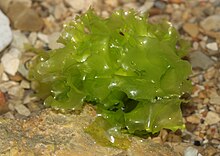Green algae

The green algae or Chlorobionta are a group of algae that used to be listed as a separate taxon in the system . Phylogenetically , however, it is a paraphyletic group because they do not contain all of the descendants of their last common ancestor . The "higher" plants ( Embryophyta ) are not counted among the green algae, although they developed from them. Green algae are therefore all representatives of the Chloroplastida with the exception of the Embryophyta.
features


The organizational forms of the green algae range from single cells and cell colonies to multicellular thalli , which z. Some remind of Embryophyta (e.g. the sea lettuce ). Single-celled species can have two or four equally long (isocontal) flagella or they can not be flagellated . In addition to multicellular forms, there are also multinucleated ( coenocytic ) forms without cellular subdivision. Their chloroplasts , like those of the embryophytes, contain the photosynthesis pigments chlorophyll a and b and often starch bodies . The cell walls have very different components; The cellulose characteristic of the embryophyta is only present in some green algae .
During sexual reproduction , flagellated gametes almost always appear, which are similar to the flagellated unicellular species. The female gametes can be flagellated and resemble the male ones (isogamy) or already differ externally from them (anisogamy), or they can be immobile egg cells ( oogamy ). The zygote is usually a thick-walled permanent cell. Most green algae are haplonts , i.e. H. with the exception of the diploid zygote, always haploid. However, there is also a heterophasic generation change in which haploid and diploid generations alternate. The two generations can be designed the same or different. In addition, asexual reproduction can occur both in the haploid and in the diploid phase , so that several generations with the same core phase follow one another.
Occurrence
So far (2014) around 4000 green algae species have been described, around 90% of which live in freshwater. Among the marine representatives, the genus Micromonas is the most common photosynthetic eukaryotes in the sea. There are also many green algae that live outside the water, especially on moist soil and trees. Some live symbiotically as components of lichens or as zoochlorella in freshwater polyps or other invertebrates .
Systematics
Today the representatives of the green algae are placed in the group of the chloroplastida , which in addition to the green algae also includes the embryophyta. The majority of the green algae is placed in the Chlorophyta , the other part with the ornamental algae and the candelabrum algae together with the Embryophyta form the Charophyta .
Web links
Individual evidence
- ^ Joachim W. Kadereit, Christian Körner, Benedikt Kost, Uwe Sonnewald: Strasburger Textbook of Plant Sciences . Springer Spectrum, Berlin / Heidelberg 2014, pp. 590f.
- ↑ a b Joachim W. Kadereit, Christian Körner, Benedikt Kost, Uwe Sonnewald: Strasburger Textbook of Plant Sciences . Springer Spectrum, Berlin / Heidelberg 2014, p. 591.
- ↑ Sina M. Adl et al .: The New Higher Level Classification of Eukaryotes with Emphasis on the Taxonomy of Protists. The Journal of Eukaryotic Microbiology 52 (5), 2005; Pages 399-451. doi : 10.1111 / j.1550-7408.2005.00053.x
- ^ Louise A. Lewis, Richard M. McCourt: Green Algae and the origin of land plants : American Journal of Botany 91 (10), 2004, pages 1535-1556. ( Full text )